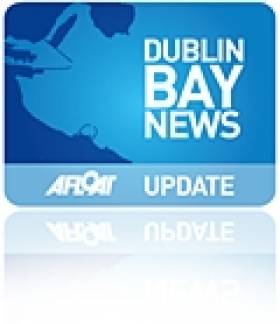Displaying items by tag: Dublin Bay News
Sky Set Sail for “Treasure Island” Shoot
Shooting is scheduled for a five-week period, starting late November in Dublin and Cork. The Earl of Pembroke is currently berthed at Dun Laoghaire's Carlisle Pier, where SquareSail crew are adapting the vessel in preparation for shooting which includes the use of the East Pier Battery. Also assisting the shoot will be the Irish National Sailing School (INSS) based in Dun Laoghaire, which for over twenty years has provided marine co-ordination services for film and TV work.
The two-part, 120 minute drama was commissioned for the Sky 1 HD TV channel. The director is Steve Barron (Arabian Nights, Merlin, England Manager) and the producer is Laurie Borg (Made in Dagenham, Little Voice, Sense and Sensibility). Also coming on-board the film-team are Irish costume designer, Lorna Marie Mugan (Killing Bono) and line producer Des Martin (Tara Road).
In the New Year the production moves to the Caribbean island nation of Puerto Rico. It is expected that the drama be released on Sky 1 HD TV in Christmas 2012.
The Earl of Pembroke is owned by Cornwall based SquareSail which specialises in providing tall-ships for film productions. The Swedish built vessel was launched as Orion in 1948 and worked bringing timber from Scandinavia to the UK. In 1974 the vessel was laid-up for several years until SquareSail purchased her in 1979. She underwent an extensive restoration programme to emerge in 1994 in the appearance of an 18th century barque.
Setting 9,500 square foot of sails, the tall-ship has 14 sails. Should the winds be slack, the 174 ton vessel has a MAN 6 –cylinder, 300hp engine which drives a three-bladed propeller. As for her silver-screen credits, they include Cutthroat Island, Frenchman's Creek, Hornblower Series III and Longitude.
Treasure Island follows the recent filming of Neverland which included shooting locations in Dalkey and Killiney in Co. Dublin and neighbouring Co. Wicklow. Both productions are part of a multi-million pound investment by Sky for their high-definition (HD) drama department.
Looking for further reading on Tall Ships in Ireland? Click the links below:
Click this link to read all our Tall Ships Stories on one handy page
Previewing Ireland's Tall Ships 2011 Season
Can Ireland Get a New Tall Ship?
MGM DBSC Challenge Kicks Off Tonight
The weekend sailnig on Dublin Bay kicks off tonight event at 5pm with the MGM Boats Dublin Bay Sailing Club Cruiser Challenge.
There will be a fixed mark course around Dublin Bay racing marks, with windward/leeward courses planned for tomorrow and trapezoid course planned on Sunday.
Last night the organisers said there was over 60 entries, expected to increase today to 70+, with travellers from as far as Bangor and Strangford Lough.
Tomorrow afternoon there will be live music and a BBQ after racing. All welcome!
Something Else is First in DBSC Cruisers One
CRUISERS 1 - 1. Something Else (J.Hall et al), 2. Jalapeno (Dermod Baker et al), 3. Powder Monkey (C.Moore/M.Byrne)
CRUISERS 2 - 1. Cor Baby (Keith Kiernan et al), 2. Red Rhum (J Nicholson)
CRUISERS 3 - 1. Chouskikou (R.Sheehan/R.Hickey), 2. Asterix (J.Counihan/F.Meredith), 3. Grasshopper 2 (K & J Glynn)
CRUISERS 4 - 1. Maranda (Myles Kelly), 2. Artemis (J.Giles), 3. Aslana (J.Martin/B.Mulkeen)
FIREBALL - 1. Licence to Thrill (Louis Smyth), 2. Good Thing (J.Dunne), 3. Blind Squirrel (Frank Miller)
GLEN - 1. Glenluce (D & R O'Connor), 2. Pterodactyl (R & D McCaffrey), 3. Glencorel (B.Waldock/K.Malcolm)
IDRA 14 FOOT - 1. Dunmoanin (Frank Hamilton), 2. Doody (J.Fitzgerald/J.Byrne), 3. Squalls (Stephen Harrison)
MERMAID - 1. Oonagh (J&M Griffith), 2. Kim (D Cassidy), 3. Aideen (B.Martin/D.Brennan)
PY CLASS - 1. Evan Dolan (), 2. Peter Craig (Laser), 3. Ross O'Leary (Laser)
RUFFIAN 23 - 1. Diane ll (Bruce Carswell), 2. Alias (D.Meeke/M.McCarthy), 3. Icicle (C & J Murray)
SHIPMAN - 1. Whiterock (Henry Robinson), 2. Bluefin (B.Finucane et al)
SQUIB - 1. Tais (Michael O'Connell), 2. Periguin (N.Coakley/J.Redahan)
The Race
The race will take place from the back of the marina breakwater in Dun Laoghaire harbour at 2pm on the 21st August 2010. The start lines for the teams will be positioned just below the hobbler's memorial on the breakwater. The race distance is 25 miles. The previous event lasted over three hours. There will be food and music on the day as well as a prize giving ceremony at a well known venue in Dun Laoghaire.
The event will be the last in the east coast skiff racing calendar and is a test of endurance.
The Tradition
As per local tradition, all teams will row traditional east coast skiffs comprising four oarsmen and one coxswain in wooden clinker-built boats. Present day racing skiffs reflect their traditional origins, and are twenty-five foot long, clinker built double-enders.Between the 18th and 19th centuries the hobblers of Dublin Bay invented the original rowing race. The skiffs would leave Dún Laoghaire, Ringsend and other nearby harbours to meet ships arriving into Dublin as far away as the Kish bank. The first crew to the ship would win the business of pilotage and unloading.
The Club
Contact Details: David CullenTel: 0868826189Email: [email protected]
Click this link for Irish Rowing detailsClick this link for the Latest Rowing News































































